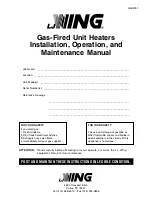
I. GENERAL INFORMATION
INSTALLATION SERVICE INSTRUCTIONS
During lifting operations, slings, or chains with
hooks and I-beam spreaders are recommended.
Lifting must be equal to all eye bolts or lugs fur-
nished. The sling spreader (I-beam or equal) must
be equal in length to the longest span between lift-
ing points. Depending on sling length one or more
spreaders are recommended. In no case should the
lift be less than 60° from horizontal or more than 30°
from the threaded shank direction of an eye bolt.
If correspondence with the factory is necessary,
provide the unit model and serial number.
This equipment shall be installed and wired in
accordance with the regulations of the National
Board of Fire Underwriters, National Electric Code,
and local governing bodies, or in Canada, the
applicable provincial regulations for the class.
Authorities having jurisdiction should be consult-
ed before installations are made. Local codes may
require additional safety controls and/or interlocks.
IMPORTANT NOTICE
TO EQUIPMENT USERS
Inspection of shipment upon arrival...
Shipments are made F.O.B., Dallas, Texas,
by rail or truck. In either case, the unit is securely
strapped, tied, and blocked to prevent shipping
damage. All shipments are checked by an inspec-
tor before they are accepted by the carrier. Parts
that are shipped unmounted are noted on the bill
of materials. These parts, where feasible, are pack-
aged and shipped with the units. Upon receipt of
shipment, all units should be checked carefully for
physical damage in the presence of the carrier’s
representative. If parts are missing or damage has
occurred, a claim should be filed immediately with
the carrier. Widely varying conditions under which
the units are transported to the jobsite, unloaded,
and installed make it impossible for L.J. Wing to
assume responsibility for handling of equipment in
transit.
All options and accessories are shipped mount-
ed and wired whenever possible - within the limita-
tions of shipping and handling. Any accessories
which include wiring that are shipped separate
(i.e., revolving discharge) require no additional con-
duit or wiring in the field.
The unit is designed to simplify field installation.
All parts have been designed to facilitate field
installation of parts and accessories. The purpose
of this manual is to supplement,
but not to replace
the services of qualified field service personnel to
supervise the initial adjustment of the unit. Persons
without previous experience with gas-fired equip-
ment should not attempt the initial adjustment and
check-out procedure essential before such installa-
tions may be considered as ready for operation.
FACTORY TEST
All L.J. Wing gas-fired unit heaters are given a
complete operational and control circuit check-out
before final shipment. A copy of the test report is
available upon request.
II. INSPECTING YOUR L.J. WING
GAS-FIRED UNIT HEATER
A. Check unit nameplates to be sure that the
model is correct.
B. Examine the furnace nameplate attached to
the air inlet to be sure that the type of gas
the unit is arranged for is the same as the
gas supply.
C. Check motor nameplate for voltage and cur-
rent rating characteristics.
Note:
If discrepan-
cies exist contact your local Wing represen-
tative.
D. Turn the fan manually to assure that it is cen-
tered in the fan ring and does not strike. If
necessary re-align.
III. INSTALLATION LOCATION
A. Allow outside air opening or provide make-up
air to tightly sealed rooms for adequate com-
bustion air.
B. Furnaces (all sides and collector box) should
not be mounted closer than six inches to
combustible materials.
C. Allow sufficient access:
1. At ends for servicing burner controls.
2. Approximately 12" between bottom of
duct furnace and service platform for
burner service.
3. On side at one access panel to allow for
2
!




